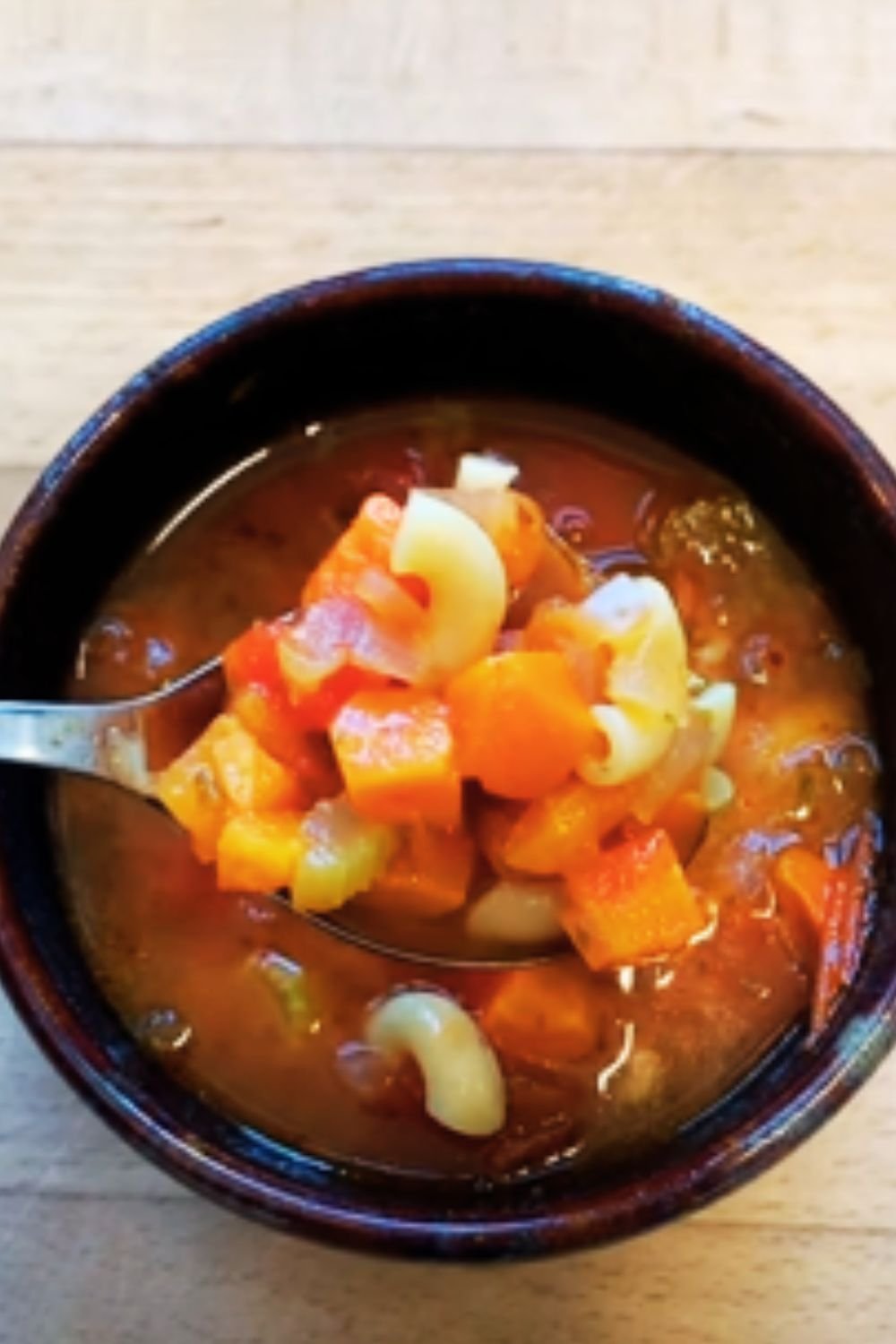There’s nothing quite like cradling a steaming bowl of homemade minestrone soup on a cold winter’s day. As someone who has spent years perfecting vegetable-based recipes, I can honestly say that this Winter Minestrone Soup is the ultimate comfort food that doesn’t compromise on nutrition. Packed with seasonal vegetables, beans, and aromatic herbs, this Italian-inspired soup is hearty enough to serve as a complete meal and versatile enough to adapt to whatever ingredients you have on hand.
What Makes This Winter Minestrone Special
I’ve been making minestrone for years, but this winter version holds a special place in my heart. While traditional minestrone is often associated with summer vegetables, this adaptation celebrates the robust root vegetables and hearty greens that thrive during the colder months. The result is a soup with deeper flavors, more substantial texture, and extra warming properties—exactly what we need when the temperature drops.
What I love most about this recipe is its flexibility. You can easily customize it based on what’s available in your pantry or what looks fresh at the market. The soup also freezes beautifully, making it perfect for meal prep during busy winter weeks.
The History Behind Minestrone
Minestrone soup has humble beginnings in ancient Rome, where it started as a simple vegetable soup made from leftover ingredients. The term “minestrone” comes from the Italian word “minestra,” which means “served up.” It was traditionally a way for Italian cooks to use up whatever vegetables were in season, paired with beans and sometimes pasta or rice for added substance.
What began as a peasant dish has evolved into a beloved comfort food across the globe. While there’s no single “authentic” recipe for minestrone (every Italian grandmother has her own version!), the common thread is the generous combination of vegetables, legumes, and often some type of grain or pasta.
Key Ingredients for Winter Minestrone

The beauty of minestrone lies in its adaptability, but here are the components that make this winter version particularly special:
Winter Vegetables:
- Root vegetables like carrots, parsnips, and turnips add sweetness and substance
- Winter squash (butternut or kabocha) contributes vibrant color and velvety texture
- Hearty greens such as kale or Swiss chard provide nutrients and beautiful color
Aromatics:
- Onions, garlic, celery, and leeks create a flavor foundation
- Bay leaves, rosemary, and thyme infuse the broth with warming aromatics
Pantry Staples:
- Canned tomatoes provide acidity and depth
- Vegetable broth forms the soup base
- Cannellini beans and kidney beans add protein and creaminess
- Small pasta shapes like ditalini or orzo (optional for extra heartiness)
The Complete Recipe
Winter Minestrone Soup
Prep Time: 25 minutes
Cook Time: 45 minutes
Total Time: 1 hour 10 minutes
Servings: 8 servings
Calories: 285 kcal per serving
Ingredients
- 3 tablespoons extra virgin olive oil, plus more for serving
- 1 large yellow onion, diced (about 2 cups)
- 3 medium carrots, peeled and diced (about 1 cup)
- 2 celery stalks, diced (about 1 cup)
- 1 leek, white and light green parts only, cleaned and sliced
- 1 medium parsnip, peeled and diced (about ¾ cup)
- 4 garlic cloves, minced
- 2 tablespoons tomato paste
- 1 teaspoon dried oregano
- 1 teaspoon dried thyme
- 2 bay leaves
- 1 sprig fresh rosemary
- 2 cups cubed butternut squash (about ¾-inch cubes)
- 1 can (14.5 oz) diced tomatoes with juice
- 6 cups vegetable broth
- 1 can (15 oz) cannellini beans, drained and rinsed
- 1 can (15 oz) kidney beans, drained and rinsed
- 1 cup small pasta like ditalini or orzo (optional)
- 1 medium zucchini, diced
- 3 cups chopped kale or Swiss chard (stems removed)
- 1 teaspoon salt, plus more to taste
- ½ teaspoon freshly ground black pepper
- ¼ cup chopped fresh parsley
- ½ cup freshly grated Parmesan cheese, for serving (optional)
- 1 lemon, cut into wedges (for serving)
Instructions
- Heat the olive oil in a large Dutch oven or heavy-bottomed pot over medium heat. Add the onion, carrots, celery, and leek. Cook, stirring occasionally, for 8-10 minutes until the vegetables have softened but not browned.
- Add the parsnip and garlic and cook for another 2 minutes until fragrant.
- Stir in the tomato paste, dried oregano, and dried thyme. Cook for 1-2 minutes to toast the herbs and caramelize the tomato paste slightly.
- Add the bay leaves, rosemary sprig, butternut squash, and diced tomatoes with their juice. Stir well to combine all ingredients.
- Pour in the vegetable broth and bring the mixture to a gentle boil. Reduce the heat to maintain a simmer, then partially cover the pot and cook for 15 minutes, or until the squash is almost tender.
- Add both types of beans to the pot. If using pasta, add it now as well. Simmer for another 8-10 minutes until the pasta is almost al dente (if using).
- Stir in the zucchini and chopped greens. Cook for an additional 5 minutes until the greens are wilted and the zucchini is tender.
- Season with salt and pepper to taste. Remove the bay leaves and rosemary sprig.
- Stir in the fresh parsley just before serving.
- Serve hot with a drizzle of extra virgin olive oil, a sprinkle of Parmesan cheese (if using), and a squeeze of lemon juice.
Nutritional Information
| Nutrient | Amount per Serving |
|---|---|
| Calories | 285 kcal |
| Protein | 13g |
| Carbohydrates | 42g |
| Dietary Fiber | 12g |
| Sugars | 8g |
| Fat | 8g |
| Saturated Fat | 1.5g |
| Sodium | 650mg |
| Potassium | 812mg |
| Vitamin A | 210% DV |
| Vitamin C | 45% DV |
| Calcium | 15% DV |
| Iron | 20% DV |
Note: Nutritional values are approximate and will vary based on specific ingredients used.
Chef’s Tips for Perfect Winter Minestrone
After making countless pots of minestrone over the years, I’ve discovered several techniques that elevate this humble soup to something truly special:
Building Flavor Layers
The key to an exceptional minestrone is developing flavor at each stage of cooking:
- Sauté aromatics thoroughly – Don’t rush the first step of softening onions, carrots, celery, and leeks. These aromatics form the flavor foundation of your soup.
- Toast herbs and tomato paste – Cooking the dried herbs and tomato paste for a minute or two before adding liquids intensifies their flavors and removes any raw taste.
- Add ingredients in stages – Add vegetables based on their cooking times. Root vegetables need longer to cook than zucchini or leafy greens.
- Finish with fresh elements – Fresh herbs, a drizzle of quality olive oil, and a squeeze of lemon just before serving adds brightness that balances the deep, cooked flavors.
Texture Considerations
A great minestrone has a variety of textures, from tender vegetables to creamy beans and toothsome pasta:
- Cut vegetables uniformly – While they don’t need to be perfectly identical, cutting vegetables in similar sizes ensures even cooking.
- Consider partially blending – For a creamier base, blend about 2 cups of the soup (beans and all) and return it to the pot before adding the final ingredients.
- Cook pasta separately – If making the soup ahead of time or planning for leftovers, consider cooking the pasta separately and adding it to individual servings to prevent it from soaking up too much broth.
Make-Ahead and Storage Tips

Minestrone is perfect for meal prep and actually improves in flavor over time:
- Prepare in advance – The soup can be made 1-2 days ahead and refrigerated. The flavors will meld and deepen overnight.
- Freezer-friendly – Minestrone freezes beautifully for up to 3 months. If using pasta, either omit it when freezing or be aware that it will soften considerably upon thawing and reheating.
- Refresh when reheating – When reheating, add a splash of fresh broth if the soup has thickened too much. A squeeze of lemon and some fresh herbs can revive the flavors.
Variations to Try
One of the joys of minestrone is its adaptability. Here are some variations I love:
Seasonal Adaptations
- Spring Minestrone: Replace winter squash with fresh peas, asparagus, and artichoke hearts. Use baby spinach instead of heartier greens.
- Summer Minestrone: Feature fresh tomatoes, zucchini, yellow squash, green beans, and fresh basil.
- Autumn Minestrone: Incorporate chunks of pumpkin, sweet potato, and Swiss chard.
Dietary Modifications
- Gluten-Free: Omit pasta or use gluten-free alternatives like rice, quinoa, or gluten-free pasta.
- Higher Protein: Add browned Italian chicken sausage or ground turkey.
- Vegan Version: Skip the Parmesan cheese or use a plant-based alternative.
Regional Twists
- Tuscan Style: Add a Parmesan rind while simmering and finish with a drizzle of Tuscan olive oil.
- Ligurian Touch: Stir in a spoonful of pesto just before serving.
- Sicilian Influence: Add a pinch of red pepper flakes and garnish with toasted pine nuts.
Serving Suggestions

To transform your winter minestrone from a simple soup to a complete meal:
Bread Pairings
Nothing complements a hearty soup like good bread. Try serving your minestrone with:
- Crusty Italian bread or baguette
- Garlic bread or bruschetta
- Rosemary focaccia
- Whole grain bread toasted with olive oil
Side Salads
Balance the heartiness of the soup with a crisp salad:
- Simple arugula salad with lemon vinaigrette
- Fennel and orange salad
- Classic Caesar salad
- Mixed greens with balsamic vinaigrette
Drink Pairings
Some non-alcoholic options that pair wonderfully with minestrone include:
- Sparkling water with lemon
- Italian soda
- Iced tea with lemon
- Hot herbal tea with mint or chamomile
Common Questions About Minestrone
Can I make this soup in a slow cooker? Yes! Add all ingredients except pasta, zucchini, and leafy greens to your slow cooker. Cook on low for 6-8 hours or high for 3-4 hours. Add pasta, zucchini, and greens during the last 30 minutes of cooking.
Is minestrone soup healthy? Absolutely! This winter minestrone is packed with vegetables, legumes, and herbs that provide fiber, protein, vitamins, and minerals. It’s a nutritional powerhouse in a bowl.
How can I thicken my minestrone? If you prefer a thicker soup, you have several options: 1) Mash some of the beans against the side of the pot, 2) Blend a portion of the soup and return it to the pot, 3) Add a bit more tomato paste, or 4) Let the soup simmer uncovered to reduce.
Can I use canned vegetables instead of fresh? While fresh vegetables provide the best flavor and texture, you can substitute some canned vegetables in a pinch. Drain and rinse them well before adding to reduce sodium content.
What’s the difference between minestrone and vegetable soup? Minestrone typically includes beans and pasta or rice, making it heartier than a basic vegetable soup. It also traditionally features Italian herbs and often tomatoes as part of its base.
Can I make minestrone in an Instant Pot? Yes! Use the sauté function for the initial steps, then add remaining ingredients (except pasta, zucchini, and greens). Cook on high pressure for 5 minutes, then quick release. Add pasta and cook on sauté function until tender, then stir in zucchini and greens until wilted.
How long will minestrone keep in the refrigerator? The soup will keep well in the refrigerator for 4-5 days. The flavors often improve after a day or two.
My pasta soaked up all the broth! What happened? Pasta continues to absorb liquid as the soup sits. If making ahead or planning for leftovers, either cook the pasta separately and add it to individual servings, or add a bit more broth when reheating.
Final Thoughts
Winter minestrone isn’t just a soup—it’s a celebration of seasonal produce transformed into a nourishing meal that warms from the inside out. The beauty of this recipe lies in its versatility and forgiving nature. Don’t be afraid to experiment with different vegetables, beans, or herbs based on what you have available.
I hope this recipe becomes a winter staple in your household as it has in mine. There’s something profoundly satisfying about transforming simple ingredients into something so flavorful and nourishing. As the steam rises from your bowl and the aromatic herbs fill your kitchen, remember that you’re participating in a culinary tradition that has sustained families through winters for generations.
Even as cooking trends come and go, a well-made minestrone remains timeless—proof that sometimes the most humble foods are the most deeply satisfying. So ladle up a bowlful, add a final drizzle of your best olive oil, and savor each spoonful of this winter vegetable masterpiece.


